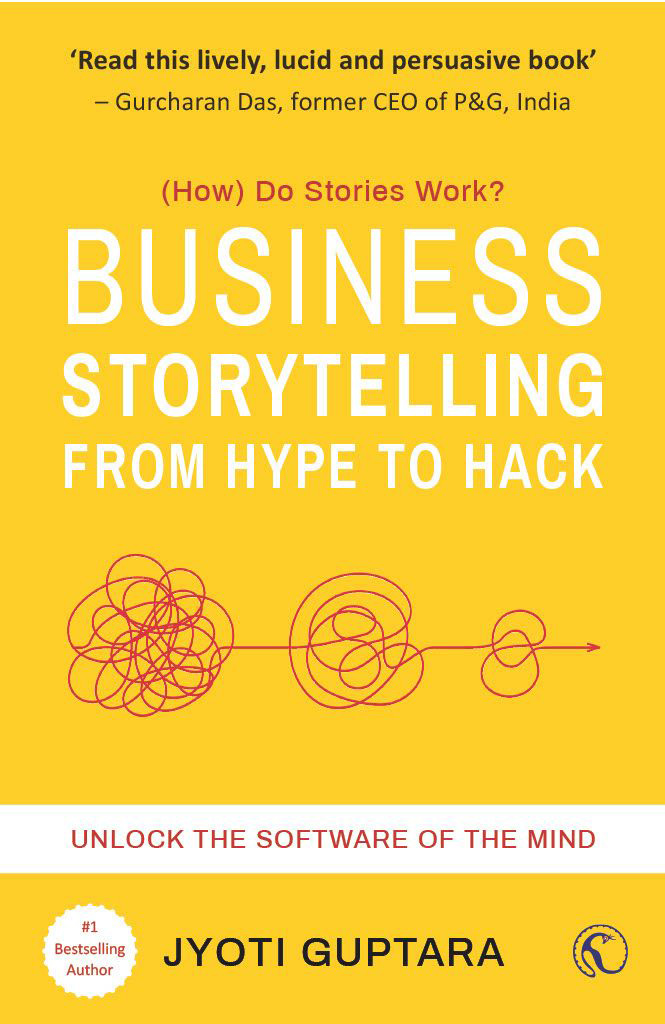By Jyoti Guptara, story strategist, speaker and bestselling author of Business Storytelling from Hype to Hack
In an age where artificial intelligence and virtual reality are becoming commonplace, the uniquely human ability to tell and connect with stories in person offers a competitive edge that can’t be replaced by machines.
Here are six key hacks that business leaders can use to transform their business with the most human of technologies – their own stories.

Alignment: hack strategy – Communicating strategy can be a challenging task. And if your strategy doesn’t connect with your employees, it might as well not exist at all. By telling stories, you can articulate your strategic vision in a compelling and relatable way that gets your team to understand and align with it by seeing themselves as part of that story. Make sure your team understands why you’re doing what you’re doing. Illustrating the ‘why’ behind strategic decisions will help team members see the bigger picture and be more invested in the vision. One way to do this is to break down the narrative into four parts. First, how and why did things work in the past? Second, what has changed between then and now? Third, what are the new priorities because of the change? And fourth, what are the challenges and potential of the change?
Interest: hack conversation and meetings – How many times have you caught yourself mentally checking out from a conversation or a meeting? Business jargon comes across as boring and tiresome – a good story, on the other hand, forces you to speak in plain language, gives people a clearer picture and keeps the energy of the room at its best.Develop a list of short stories to communicate what you do, to answer frequently asked questions, and to counter common objections in conversations. Try not to pack in more than one point into each story. By leaving out what’s unnecessary you will avoid misunderstandings, cut through complexity and keep the listener interested.
Empathy: hack trust – Studies have found that even in a business context, trustworthiness is more important than competence. Storytelling is an excellent way to build a foundation of trust which will help your message to connect with your audience.When people hear a story, they often respond by sharing one, which is great, because a story is a vicarious experience and a shared experience strengthens trust. Just like we tend to trust someone more if we’ve collaborated positively, we trust them more after hearing and sharing a story.
Desire: hack sales – People buy for emotional reasons and justify the decision rationally later. Sometimes while making presentations, salespeople can appear robotic – why not humanise the pitch by including stories which will generate conversations that are more meaningful and relatable?
For a good sales pitch to land, collaboration rather than confrontation works well. You can overcome objections by addressing potential concerns indirectly. Model the sale for your prospect by talking about a customer with similar problems to them and how you were able to help. By telling them what was at stake and how you made a difference, you can demonstrate your understanding of the prospect’s needs and pain points as well as your competency. Lastly, talk about the success and how your client felt at the end of it all. This is what your new prospect wants to feel, which is why they are much more likely to work with you now, having heard your sales story.
Destiny: hack yourself – The stories we tell ourselves determine our beliefs, attitude, and actions, and often become a self-fulfilling prophecy. Our stories don’t just shape our personalities, they are our personalities. Who am I and what do I want in life? What do I care about? Why do I do what I do? These are all story questions and the way you answer these questions will become a part of your meta-narrative. There must be an alignment between the stories you tell yourself, and the stories you tell others. We always have the option to reframe our story, edit our self-narrative and change our story to change our world.
Much of the above advice relates to matters of detail, but all details contribute to the overall culture of a business. As the popular saying goes: “culture eats strategy for breakfast”, which leads us to the final hack for this piece.
Behaviour: hack culture – Strategy should guide behavior, but to do that effectively, it must align with your culture. But how can one influence culture? By changing the stories. When stories illustrate values in action, they model and reinforce desired behaviour and inspire buy-in for purpose. Changing organizational stories is a great way to bring about cultural change. Purpose-driven leaders elevate storytelling from a mere marketing or public speaking tool to a strategic asset that transforms every facet of their work and organisation.








